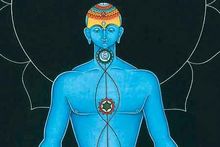Swami Vivekananda, among the foremost disciples of Sri Ramakrishna Paramhansa, was of the view that each soul is potentially divine and the purpose of meditation is to manifest this divinity within through awakening of the dormant Shakti or power, kundalini. In his ‘Raja Yoga’, Swami says, “Rousing of kundalini is the one and only way to attain divine wisdom, super conscious perception, realisation of the spirit”. Why did he attach so much importance to rousing of kundalini to attain Self-realisation?
Shakti, in the process of manifesting as Brahmanda or Universe, divides herself into two polar aspects -- static and dynamic. This implies that any given sphere of activity would have its corresponding static background. In the human body too, which is referred to as kshudrabrahmanda or microcosm, the same polarisation can be observed. Mahakundalini, in Supreme form is at rest in the highest spiritual centre in the sahasrara or brain, coiled around and one with Shiva-bindu. Then, by her own free will, she begins to uncoil herself in order to manifest. As she continues to uncoil, the tattvas and the matrikas emanate from her. She first creates mind and then matter and goes on uncoiling until earth or prithvi, the last of the tattvas, has been evolved.
After having created prithvi, earth, Shakti again assumes static form, meaning thereby that at muladhara or root-support, the seat of prithvi tattva, Kundalini is at rest as the residual power -- the power that is left over after the process of creation has been completed. Just as mahakundalini coiled around Shiva (before manifestation) is static potential, similarly, the kundalini power in each body is the power at rest or the static centre round which every form of existence as moving power, revolves.
The tattvas mentioned above are embedded in the body in a subtle form, within the sushumna which in yogic terminology are referred to as chakras. The first five chakras, namely, muladhara, swadhishthana, manipura, anahata and vishuddha, are centres of the five tattvas -- earth, water, fire, air and ether respectively. The sixth chakra, ajna, is the seat of the mind. From each of these radiate thousands of yoga nadis, conduits of pranic force, in different directions. Swami Vivekananda says that among these, only three nadis are of prime importance, namely
ida associated with moon that ends up in the left nostril, pingala associated with sun that ends up in right nostril and sushumna, the hollow passage that runs through the spinal cord and ends in brahmarandhra, the tenth opening in the brain. At the lower end of the hollow canal is what Swamiji calls ‘Lotus of the Kundalini’.
The purpose of arousing the dormant kundalini, says Swamiji, is to get the prana out of ida and pingala and make it enter sushumna, the hollow passage. Through regular practice of meditation and pranayama and by leading a chaste life, the mass of energy stored in muladhara begins to travel along the sushumna with tremendous force, being drawn to the other static centre in the sahasrara. In the process, the chakras get pierced and considerable amount of ‘ojas’ or sexual energy gets transmuted into spiritual energy and gets stored in the brain, enabling the seeker to experience the vision.
Finally, says Swamiji, when the awakened kundalini unites with Consciousness at sahasrara, the summit, the seeker enters the sublime state of nirvikalpa samadhi wherein he experiences infinite bliss and “the full blaze of illumination, the perception of the Self”.
